Any kind of surgery requires a period of recuperation and healing, and a total knee replacement is no different. After your knee replacement, the muscles and tendons around the knee are going to be sore, sensitive, and weak. It is important to follow all instructions sent home with you after your total knee replacement surgery. This will include specialized exercises to strengthen the muscles and promote flexibility in the joint, a regimen of ice therapy, and specific ways to sit, stand, lie, and rest.
Immediately after your total knee replacement, you will probably experience swelling and discomfort, which can last up to 6 months following the surgery. Applying ice to the affected knee will help reduce discomfort and swelling. This should be done 3 or more times a day as needed for about 10 to 20 minutes at a time. After exercising, walking and other movement, ice is highly recommended and should be used at least 3 times daily for the first 6 weeks after surgery. Apply the ice pack to a straightened knee while lying down. The foot of the affected knee should be slightly elevated on something like a rolled up towel.
The movements and positions you assume while sleeping are completely subconscious, but try to keep the surgery affected knee straight while lying down or sleeping. It may help to keep a rolled towel under the foot of the affected leg. Do not place anything under the knee to force it into a bent position. Instead keep the knee as straight as possible.
Sitting for long periods of time may cause additional discomfort and swelling, and sitting is not recommended for more than 45 minutes at a stretch. If the patient must sit for longer than 45 minutes at a time, be sure to take frequent breaks and walk around to move and stretch the knee.
Infections are a concern after any surgery and for total knee replacement can happen up to a year later. If you experience any of these symptoms, seek emergency medical treatment immediately.
Long periods of fever
Redness and pain from the wound
Discharge from the wound
Intense pain in the knee.
During your recovery, your doctors and physical therapists will be giving you various exercises. These exercises are designed to build strength and increase flexibility in the joint. These exercises may include, but are certainly not limited to: ankle pumps, heel slides, leg raises, side lying abduction (leg lifts), sitting knee extensions, and standing exercises. Please follow all directions given completely and accurately.
Another part of your recovery may include the use of physical aids such as crutches or a walker. Once again, following the directions you are given is very important, since physical injury is possible if you do not abide by them
SITTING OR BACK LYING
1. Quad Set Exercise
- Tighten the muscles on top of the thigh as tightly as possible and hold.
- Pull your toes back.
- Push the back of your knee down to the floor.
- Try to push out and up through the heel.
- Pull 10 seconds, trying every second to pull even tighter.
- Relax 5 seconds.
- Repeat for 2 sets of ten times. Rest 60 seconds between sets.
| 
|
2. Knee Extension with Leg Lift
- Start as above, but with a full toilet paper roll under your heel.
- Push knee down.
- Lock it.
- Lift leg up.
- Then lower to roll.
- Repeat for 2 sets of 10 times.
| 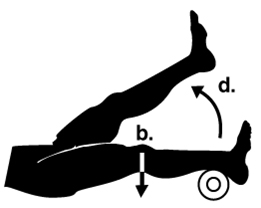
|
3. Drake Exercise
- Tighten top of thigh muscles.
- Hold this for 2 seconds.
- While maintaining hold, raise leg 4 " from floor.
- Hold this position for 2 counts (1-1000, 2-2000).
- While maintaining tension, lower leg to floor.
- Hold tension for 2 counts while leg is down.
- Rest for 5 counts.
- Repeat for 2 sets of 10 times.
| 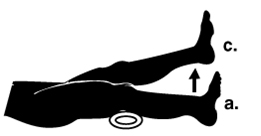 |
4. Static Hold Exercise
- Place a hard, round object or toilet paper roll under your knee to hold it at a height of 4-6".
- Keep back of knee in contact with object at all times.
- Lift heel off table as high as possible.
- Straighten knee and tighten top of thigh as tight as possible.
- Hold for 5 seconds.
- Rest for 5 seconds.
- Repeat for 2 sets of 10 times.
|
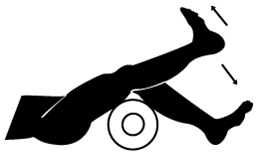
|
5. Straight Leg Raise
- Tighten the muscles on top of the thigh as tightly as possible and hold.
- Raise the entire leg holding the knee as tight as possible. Hold 5 seconds.
- Lower leg and rest 2 seconds.
- Repeat for 2 sets of 10 times.
- Rest 1 minute between sets.
| 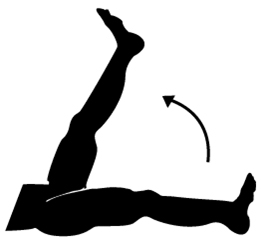
|
6. Heel Slide
- Lie on back with legs out straight and back flat.
- Slide one heel up, bringing knee toward chest.
- Then slide heel back down.
- Repeat for 2 sets of 5 times.
| 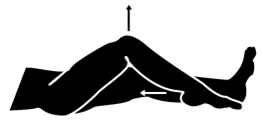
|
7. Hamstring Set Exercises
- Bend the knee to a height of about 6".
- Tighten the muscles on the back of the thigh fully by pulling down and back with the heel. The heel should remain stationary.
- Pull for 5-10 seconds, trying every second to pull even tighter.
- Relax 5 seconds.
- Repeat for 2 sets of 5 times, resting 60 seconds between sets.
| 
|
8. Flexion and Extension
- Sit on something high enough to keep foot off the floor.
- Bend the knee as far back as possible.
- Straighten knee as far forward as possible and hold it straight.
- Then relax. (Like pumping on a swing.)
- Repeat for 3 sets of 10 times.
| 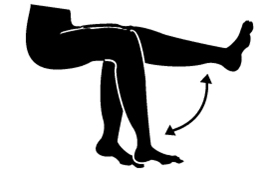
|
9. Assisted Knee Flexion
- Sit as above.
- Place ankle of good leg over ankle of operated leg.
- Gently push ankles back, bending knees.
- Hold and then relax.
- Repeat for 2 sets of 5 times.
| 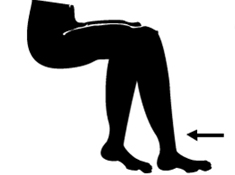
|
10. Assisted Knee Flexion
- Lying on your stomach, bend involved knee up.
- Use uninvolved leg to help push knee into more flexion.
- Hold for 10 seconds.
| 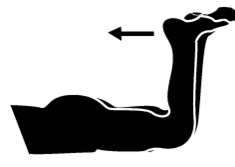
|
|